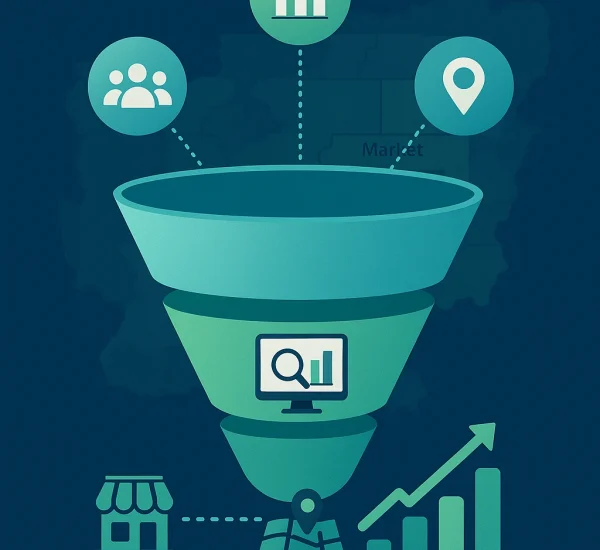Offering great products and services is no guarantee of business success. There are numerous examples where smart engineers, designers, and former business owners built a product of better use and quality but failed over time. Regardless of the individual reasons, there is one common truth: A business must grow to be successful in the long run; Seasoned businesses embrace market development strategies for persistent growth and success.
Market development is a growth strategy that goes beyond branding and marketing efforts. There are many frameworks that visually approach growth strategies. From a simple BCG growth matrix to a more complex Ansoff matrix: Successful businesses are built upon a funnel of new ideas, products, and markets.
In this article, we will look at market development and the importance of location intelligence. Beginning with a brief overview and crucial definitions, this article will focus on the development strategies. Ultimately, we will show an example of how location intelligence data and market development are intertwined.
What is a Market Development Strategy?
Market development is a growth strategy. Its focus lies on expanding businesses by discovering and addressing market opportunities. Essential market development tasks involve: identifying hidden opportunities, analyzing their business relevance and potential, and strategically targeting them. Measures include market expansion, extension, and consolidation.
Key Differences of Growth Strategies
Market development is an umbrella term for processes and strategies. We often see that market development is interchangeably used with other growth strategies. While they share similarities, it is crucial to understand the differences to, e.g., market penetration and product development. So, let’s briefly look at their approach to business growth and customer base.

Market Development vs Market Penetration
Market development is a growth strategy that explicitly targets new markets. Using the existing product and service portfolio, its focus is expanding to new geographic areas. In contrast, market penetration targets existing markets, ultimately increasing the market share.
Market Development vs Product Development
Product development focuses on introducing a new product for an existing market. Its primary focus is solving customer pain points, thus typically growing the customer base by innovation. In contrast, market development extends existing products into new markets and expands the customer base by scaling.
Putting it together: What is Market Development?
From the previous distinctions, we can derive what market development is about. Market
development is an umbrella for methods and strategies to introduce and promote existing products and services in new geographical markets.
All three approaches are equally important business growth strategies, with different approaches and suitability. Whether through new or existing markets and customer bases, products and services, Successful businesses use a mix of those strategies.
The 3 Market Development Strategies: Bridging Market and Development

So far, we’ve covered the general focus of market development and made a crucial distinction between three growth strategies. Looking at market development, we can further distinguish between three approaches:
- Market Expansion (Geographic)
- Market Extension (Diversification)
- Market Consolidation (Strengthening)
Having a clear understanding of these directions is essential. There is no universal approach to market success. Each business situation is unique and is subject to individual market dynamics. That’s why businesses must individually weigh the pros, cons, and risks of each approach.
Essential Risks of Market Development Strategies
Before looking at the three most popular market development strategies, it is crucial to understand the risks. Market development is a complex approach that includes numerous opportunities and poses significant risks.
New market entries require substantial upfront investments, often with no guaranteed, immediate, or measurable outcome. Potential investments range from increasing stock and production capacity to building new sites. There is no blueprint, but following a strategic approach and acquiring comprehensive market and customer data can help mitigate these risks.
Expanding into new markets naturally leads to more competition. An increase in competition can result from established, local businesses and other businesses simultaneously targeting the same new markets. Competitive data and local market insights are essential to assess local market conditions.
Therefore, identifying and deciding on the most promising approach requires expertise and data. Location intelligence data is a valuable source for supporting strategic planning processes in market development. That is, support in realistic target setting and mitigating market development risks.
In the following, we’ll have a look at the three approaches and specifically highlight the benefits and extent of data required for confident decision making. Keeping the risks in mind, let’s start with expansion.
Market Expansion: Geographic Market Development
A market expansion approach increases revenue and market share by allocating new geographic markets. Local markets differ in competitiveness and customer demographics. Businesses use comprehensive target market analysis to uncover distinct market compositions and dynamics.
Geographic expansion is a high-risk investment. Failure in market expansion initiatives can result in financial shortcomings and potential bankruptcy. Therefore, proper risk management in market expansion is necessary. Businesses can lower risks by identifying white spaces, market characteristics, and local economic trends. With these insights, businesses can compare different strategies, markets, and lower barriers for a successful market entry.
Market Extension: Diversification through new Customer Groups
An alternative approach is extending products and services into new customer segments. The potential benefit of this approach depends on the composition of the existing markets. Essential insights into customer demographics and psychographics are necessary to determine market opportunities. Customer behavioral analysis supports decision-making.
Depending on the individual customer and market composition, this approach yields significant growth potential. Success isn’t guaranteed; however, the investment and risks of a diversification strategy are generally lower than those of a market expansion strategy.
Market Consolidation: More than optimization
Market consolidation focuses on the businesses’ position within existing markets. This approach is more of an umbrella term for various optimization programs and strategies. For simplicity, we can assemble two categories:
- Business-focused
- Supply-chain & distribution optimization
- Strategic mergers, acquisitions, and partnerships
- Customer-focused
- Retention strategies
- Relationship
- Brand awareness & loyalty
In comparison, the consolidation approaches are generally on a smaller scale. Individual business goals and scopes vary, thus generally posing lower risks. However, tremendous opportunities fit most businesses in scope and budget: Competitor and market analysis can uncover distinct market patterns, eventually converting into a competitive advantage.
Market Development by Example: Expansion and Diversification in Retail
The main factor for retail businesses’ success is location. However, retail businesses are expensive to set up and often challenging to supply. Expansions often involve site selection, implying building or acquiring new sites. Hence, market development for retail businesses is especially cost and planning-intensive. On top of that, retail businesses do have distinct requirements:
- Large floor plan requirements
- Nearby or site-exclusive parking
- Accessibility expectations and requirements (customers and suppliers)
Apart from these limiting factors, what makes a good retail location?
Essential Considerations for Retail Business Location
There is no universal template for good retail locations. Every store and each chain have unique characteristics and business models. However, there are some fundamental questions when searching for a good retail business location:
- What is a large enough space?
- How many parking lots are sufficient?
- How large is the trade area for that location?
- How big is the population inside that area?
- Are there enough primary customer personas?
While this is not an exhaustive list, location intelligence software can assist business planners. Spatial insights can support these tremendously important questions and enable trade-offs:
- Pop-up stores benefit from high-density areas and plenty of seasonal foot traffic (e.g., weekends), while parking and traffic connections are a lower priority.
- Retail chains benefit more from parking and accessibility, placing them close to complementary shops to attract more customers. Having all weekly necessities in one place is often more important than proximity.
Building size, floor plans, traffic, roads, and parking conditions are only physical aspects of a good retail location. What makes a retail business genuinely successful, especially in the market development angle, is its market fit. That is, doing business in the right market, having an appropriate product offering at an appealing price—the secret: Market insights.
Comprehensive market insights include spatial demographic and psychographic data, allowing for customer insights and geodemographic segmentation. This data helps business developers in determining optimal trade areas and ideal customer bases. Furthermore, businesses can utilize this data to fine-tune the stores’ assortment while leveraging local spending habits for optimal pricing.
Success through Data-driven Market Development
Market development is a crucial task for successful businesses. We have examined the definition of market development, three popular approaches, and examples. Each business, industry, and market are individual.
Planning and building a market development strategy come with limitations and risks. Market entry risks are exceptionally high for businesses requiring physical presence instead of e-commerce and distribution. Successful market development is a strategic process that combines data and expertise.
Your Business, your Strategy – our Location Intelligence
Discover how our location intelligence platform simplifies market development. At Mapchise, we can present the local market insights supporting your case. Find out where to invest and expand. From simple facts to substantial insights: Our data foundation enables both comparisons and decisions.


